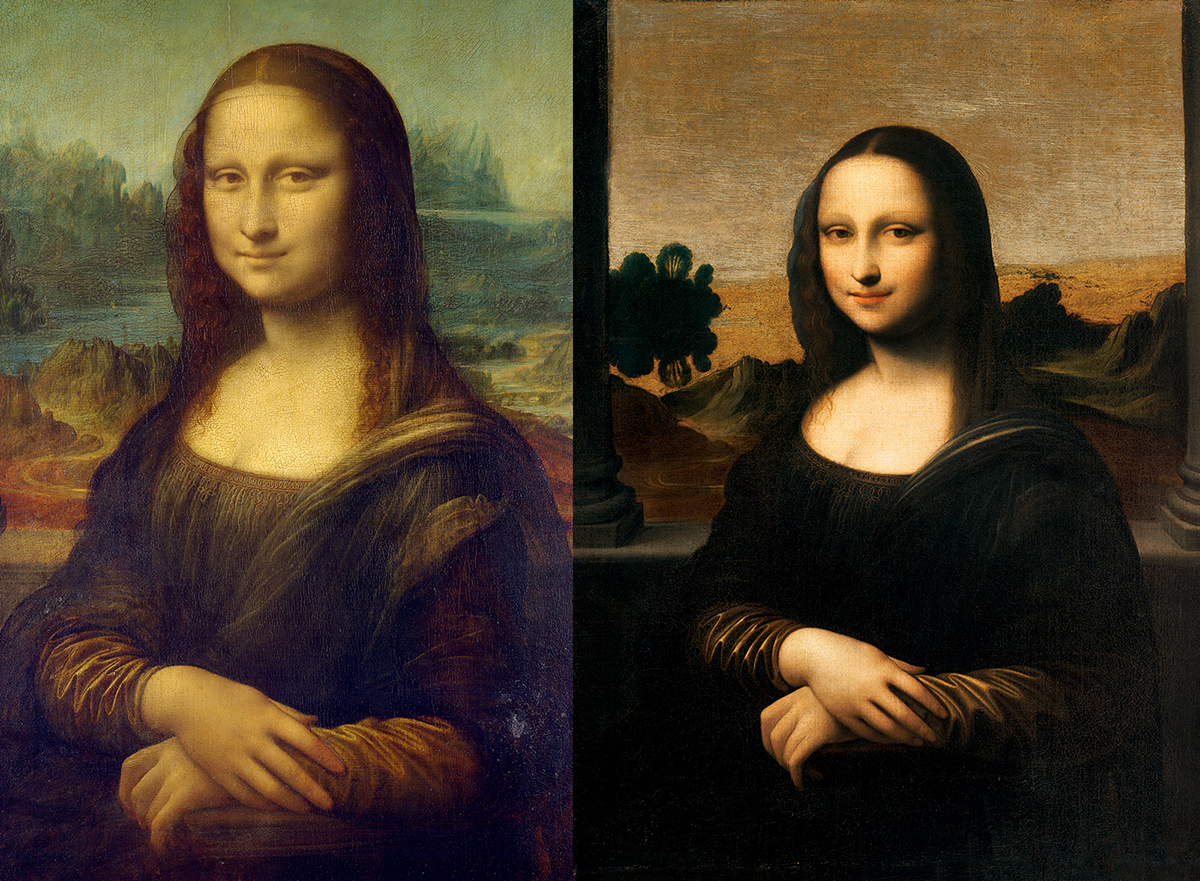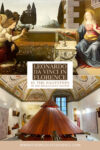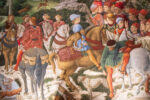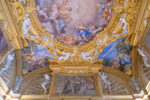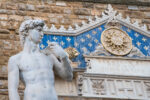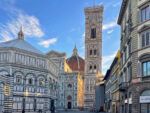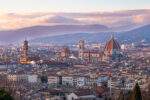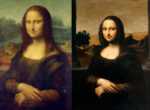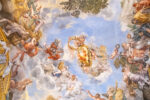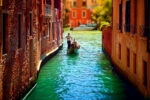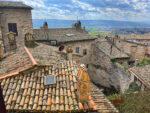Leonardo da Vinci, the true Renaissance man, emerged as a shining beacon of creativity, intellect, and artistic genius in the vibrant city of Florence. During the 15th and 16th centuries, Florence thrived as a cultural centre, nurturing extraordinary talents that would forever shape the course of history. In this remarkable setting, Leonardo da Vinci took his first steps towards becoming an iconic figure in the realms of art, science, and invention.
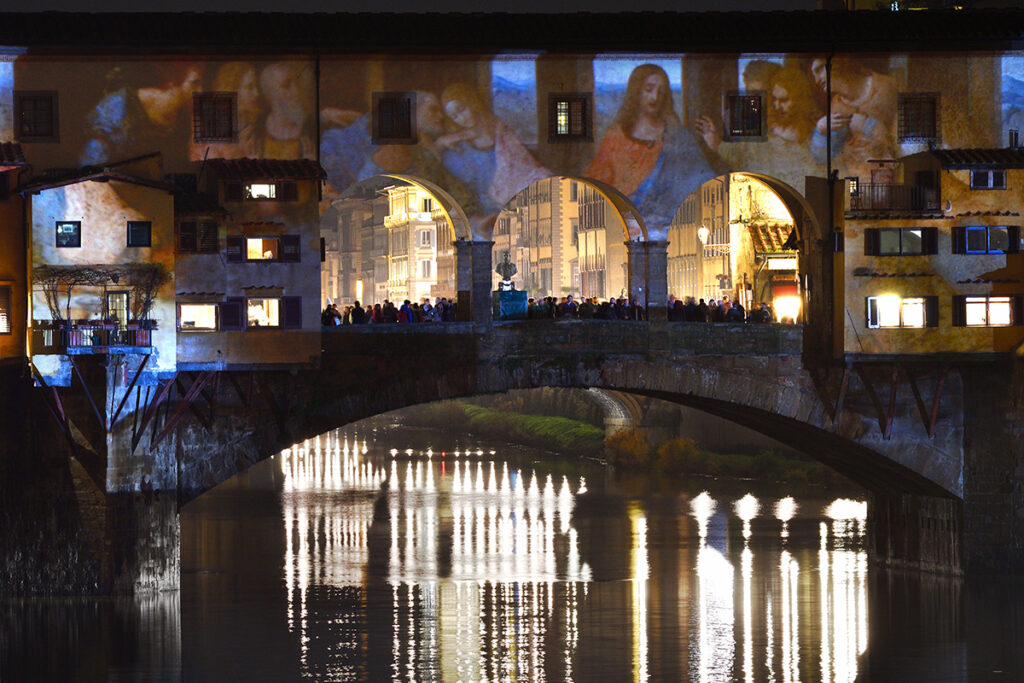
Born in Vinci, a small Tuscan town, in 1452, da Vinci moved to Florence as a young man, where he began his artistic apprenticeship under the tutelage of Andrea del Verrocchio, a renowned Florentine painter and sculptor. In the fertile ground of Florence, da Vinci’s boundless curiosity and insatiable thirst for knowledge found fertile ground, fueling his passion for the arts and sciences alike.
The beauty of walking in the footsteps of Leonardo da Vinci in Florence is that they take you to some of the most iconic sites in Florence as well as to some of the city’s hidden gems. So, if you have more than 2 days in Florence and would like to venture off the beaten path, uncovering da Vinci’s Florence is a fascinating opportunity to do that.
And if you prefer guided exploration, consider this 2-hour Leonardo da Vinci walking tour.
Ufizzi Gallery
The journey into the world of Leonardo da Vinci in Florence starts in the Uffizi Gallery. This is where only three of da Vinci’s paintings in Florence can be found. One completed painting – The Annunciation (1478), one unfinished – Adoration of the Magi, where he included a self-portrait (1481), and his angel on Verrocchio’s painting of the Baptism of Christ (1475).
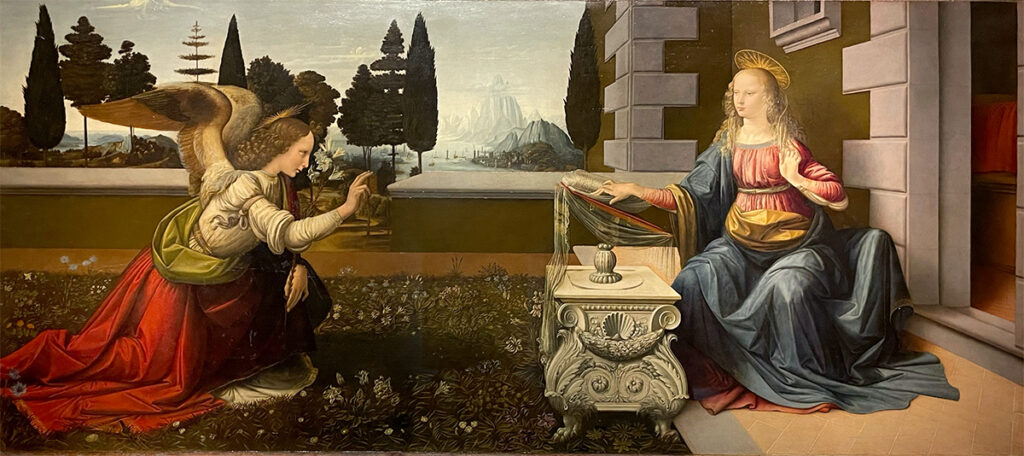
Created around 1472-1475, the Annunciation is one of Leonardo’s earliest paintings. It depicts the biblical scene of the Archangel Gabriel’s visit to the Virgin Mary, announcing to her that she will conceive and give birth to the son of God, Jesus Christ.
Although the “Annunciation” is an early work, it already displays some of the characteristics that would define da Vinci’s later artistic style. These include his mastery of light and shadow, his use of sfumato (a technique of blending colours and tones to create a soft, hazy effect), his exploration of human anatomy and facial expressions, and his meticulous attention to detail.
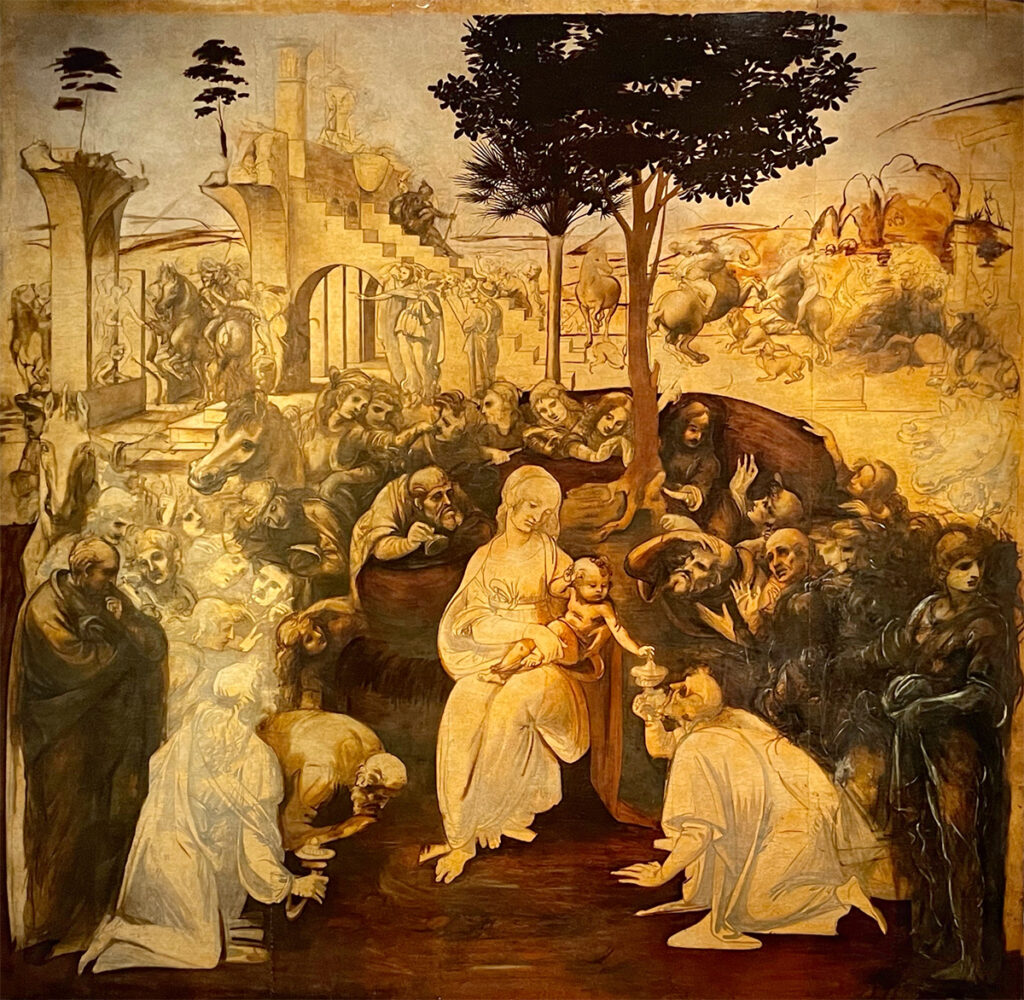
The unfinished Adoration of the Magi is fascinating for the sheer amount of detail that makes up Leonardo’s paintings. There are a dozen different stories weaved together into a single scene. It is almost like seeing what was in his mind as he worked on the painting. All the moving parts that would’ve come together had he finished the painting.
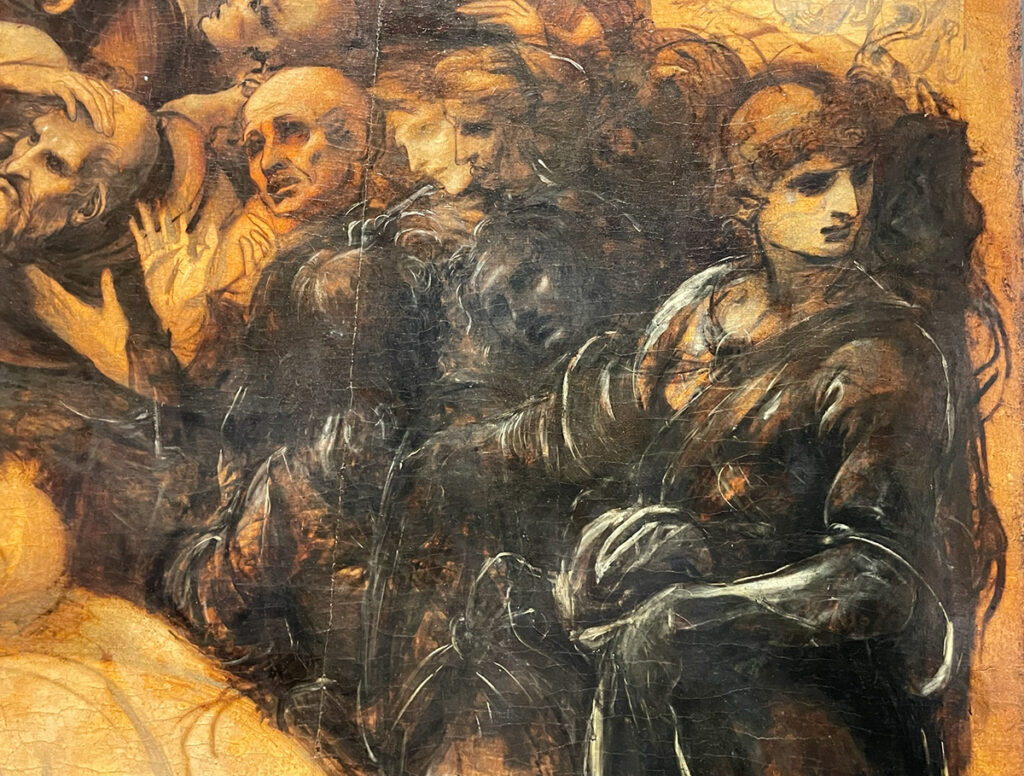
The supposed self-portrait is an intriguing detail since no images of young Leonardo exist, and Vasari described him as a very handsome and charismatic man.
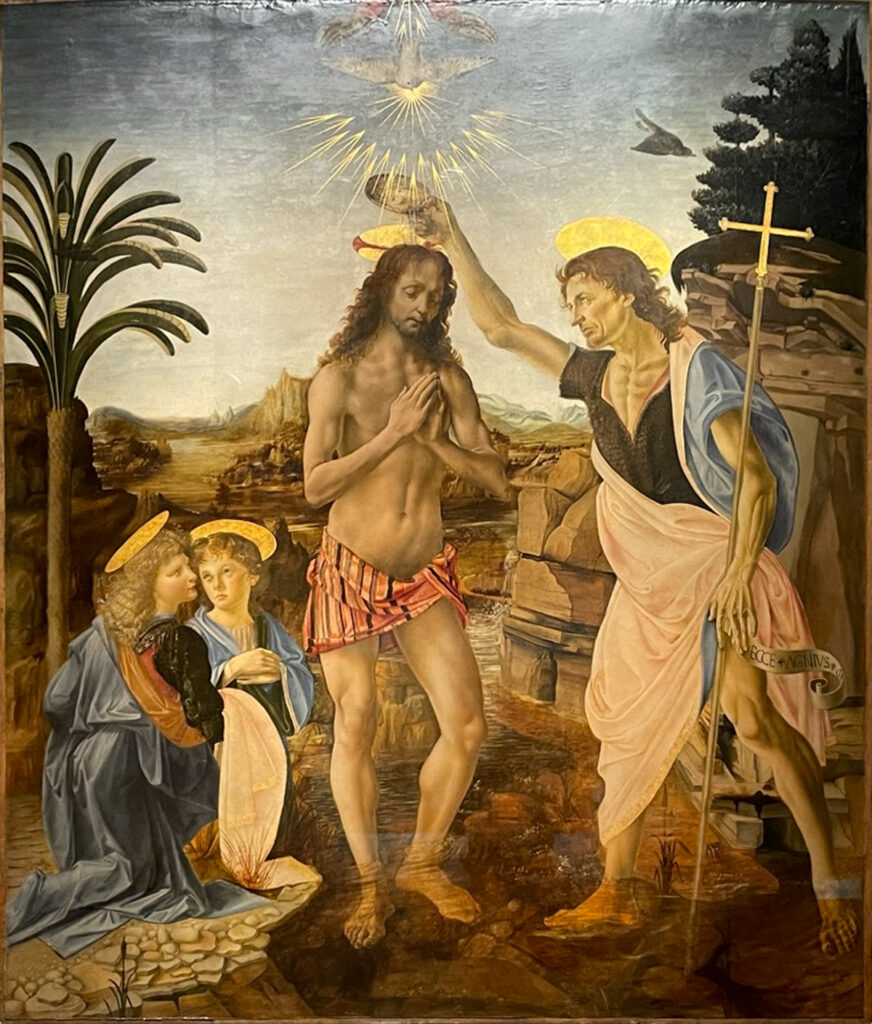
The final painting in the room, Verrocchio’s Baptism of Christ, is significant because it features the work of a young da Vinci, his apprentice at the time.
Leonardo da Vinci’s contribution to the painting is believed to be the figure of the angel. It is said that da Vinci’s talent was so remarkable even as a young artist, that Verrocchio felt intimidated by his skill and decided to quit painting altogether.
The angel, attributed to da Vinci, is a beautiful and ethereal figure with graceful, flowing drapery and a serene expression. The delicate features and the elegant pose of the angel are characteristic of da Vinci’s artistic style.
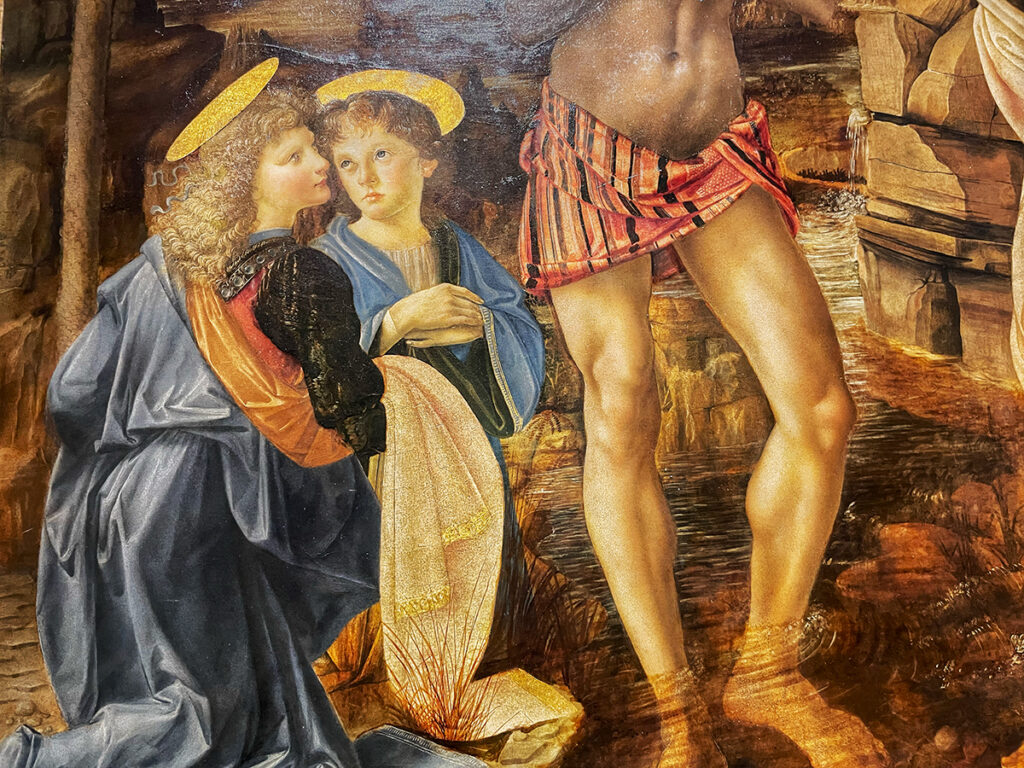
Keep in mind: If you’re visiting Uffizi Gallery for the first time, consider taking a guided tour. The museum is vast, and it’s easy to get lost in the sea of art. But it is absolutely spectacular and a must-see even if you only have 1 day in Florence.
Beyond these three paintings, the only traces of Leonardo da Vinci in Florence are the places that are associated with his life and work in the city.
Palazzo Vecchio
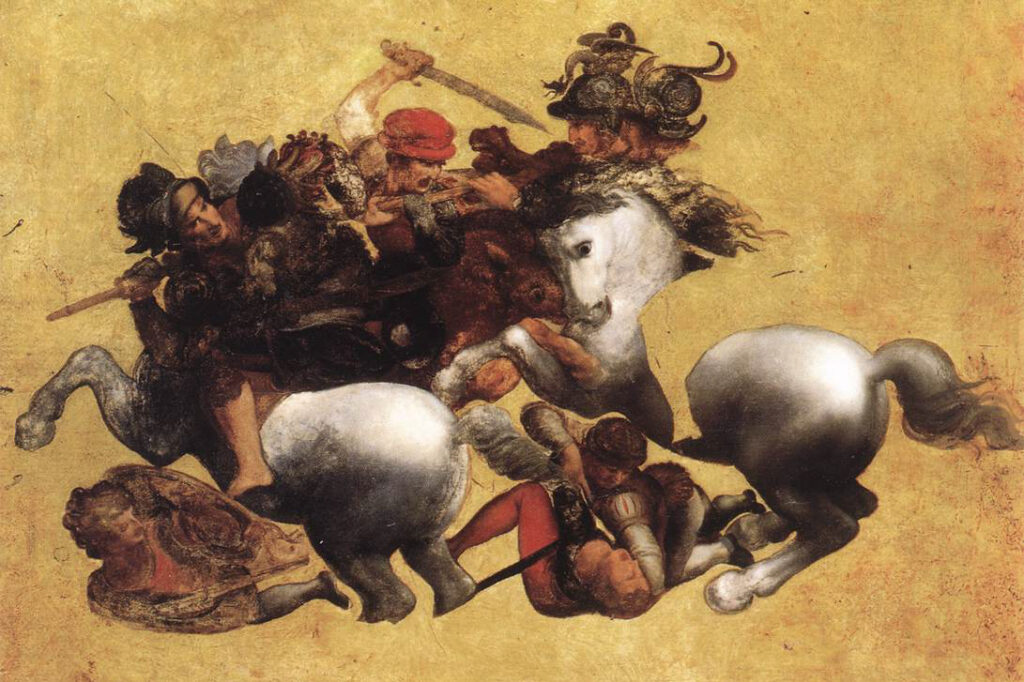
In Leonardo’s time, this medieval fortress was called Palazzo della Signoria – the civic heart of Florence. In 1503, he was commissioned to paint a grandiose mural of the Battle of Anghiari in what is now the Hall of the 500, but at the time was the Great Hall of Signoria. At the same time, his rival Michelangelo was designated the opposite wall for a mural of another battle.
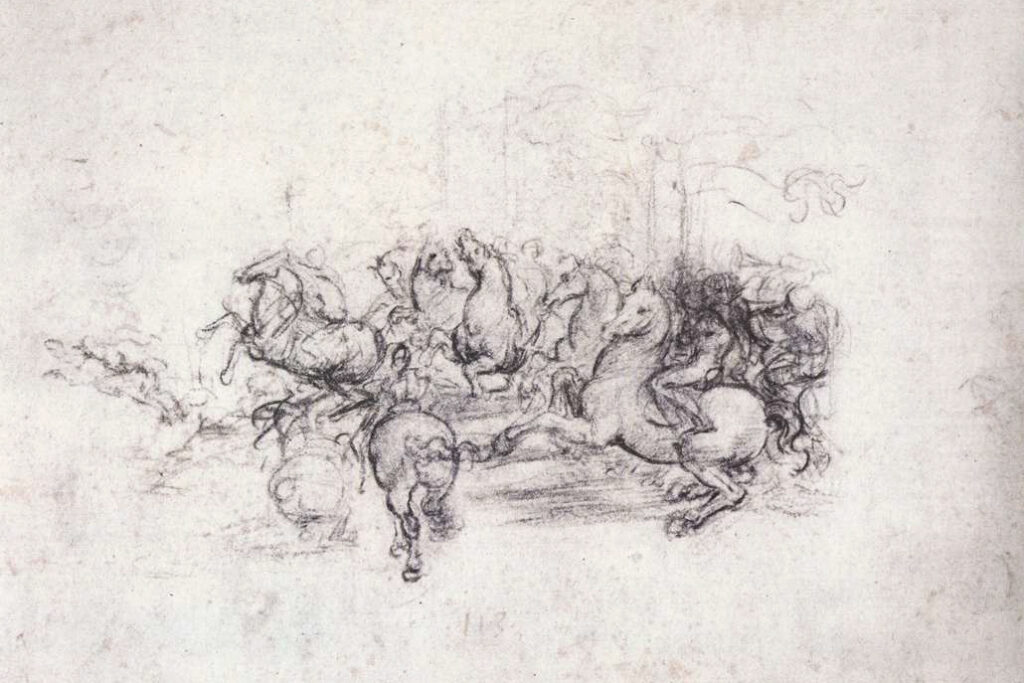
In preparation, Leonardo da Vinci drew his large cartoon in the Basilica of Santa Maria Novella. He built an ingenious scaffold in the Hall of Five Hundred that could be raised or folded in the manner of an accordion.
This painting was to be his largest and most substantial work. However, always the experimenter, Leonardo used a new type of paint that began to drip before the painting dried up. Leonardo tried to salvage the painting, but it was too late. Frustrated, he abandoned it, as he often did with his artworks.
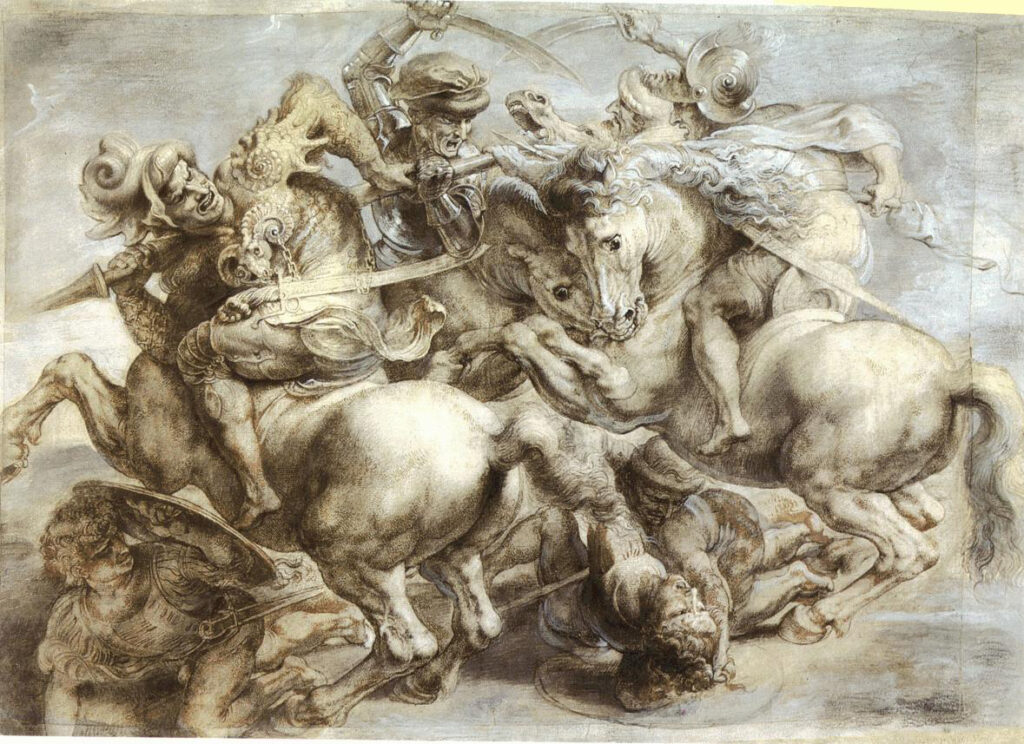
The unfinished fresco remained on the wall of Palazzo Vecchio, and in the intervening centuries, several artists made copies of it (one of them is displayed in the Apartments of the Elements upstairs).
Legend has it that when Vasari was commissioned to remodel the hall, he built a false wall over Leonardo’s fresco to preserve it instead of painting over his work. Vasari left a cryptic clue on one of the battle flags on his fresco, a barely noticeable inscription 12 meters above ground that reads “Cerca Trova” or Seek and ye Shall Find.
Considering that only 15, possibly 16 paintings by Leonardo da Vinci are believed to exist, the possibility of discovering the Battle of Anghiari is fascinating.
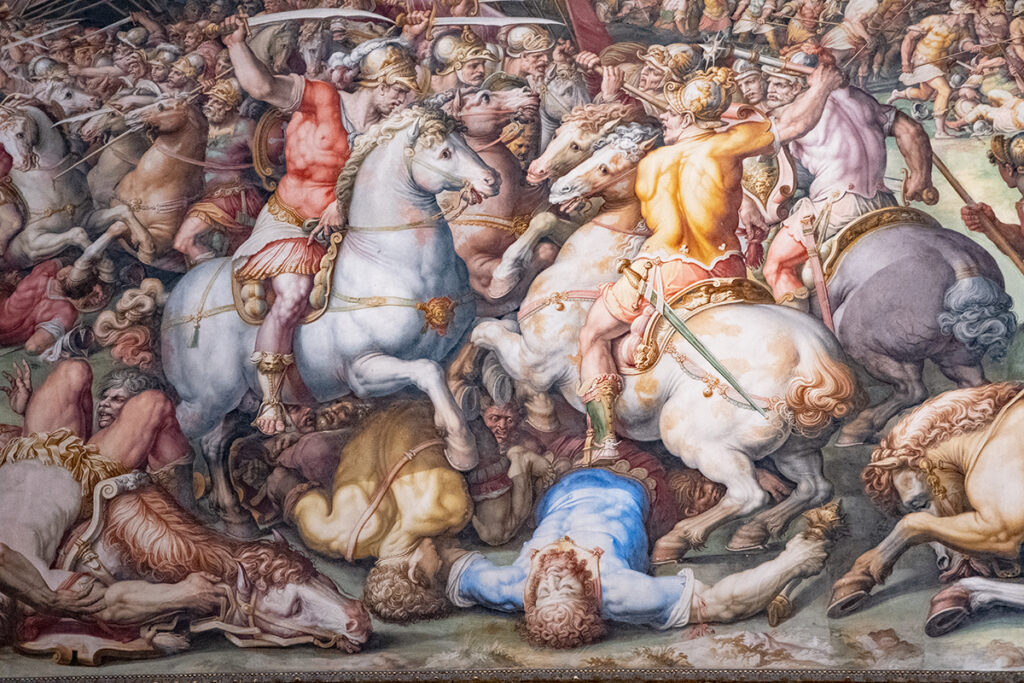
There have been several attempts to examine the wall beyond Vasari’s fresco, which provided promising but inconclusive results and in 2012, efforts to investigate further were discontinued.
If you explore Palazzo Vecchio on a guided tour, make sure to ask your guide to point out the Cerca Teova inscription to you. It’s very difficult to explain where it is.
And speaking of guides and tours… If you are a fan of da Vinci, you probably enjoy puzzles and secret messages. There is a tour run by Palazzo Vecchio that you will love. It’s called the Secret Passages tour. From the get-go, this tour takes you into a secret passage and plunges you into medieval Florence. You move between the areas of the palace via the passages concealed within its walls, entering secret nooks and crannies built as sanctuaries by the Medici family members.
Piazza della Signoria
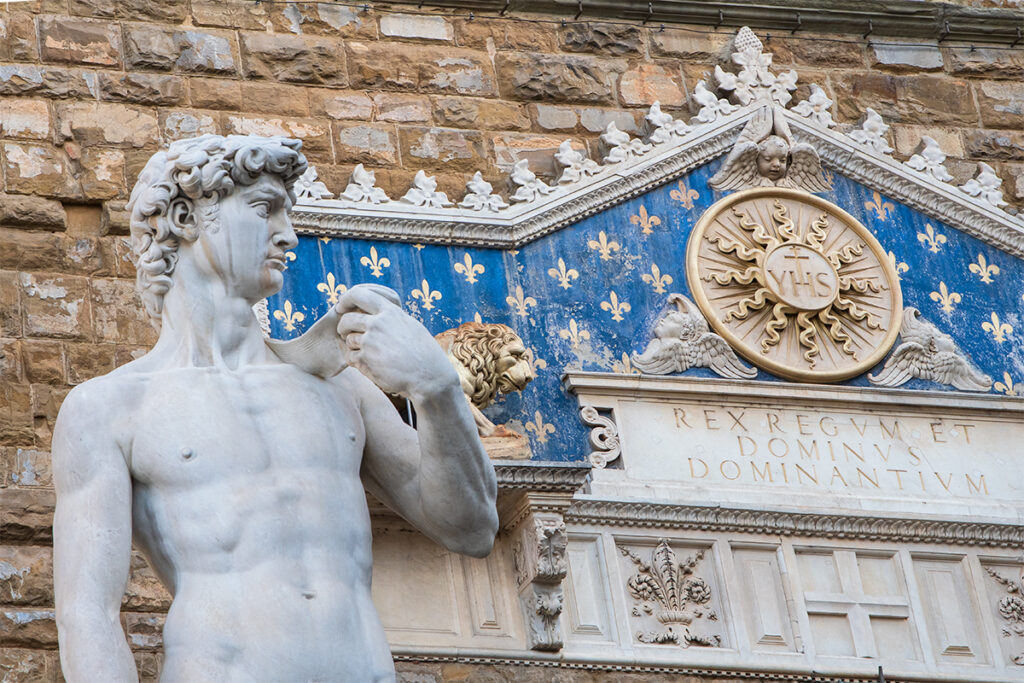
Today, a copy of Michelangelo’s David guards the entrance to Palazzo Vecchio. Originally intended to be placed on the roof of the cathedral’s dome, the 6-ton statue proved to be impractical to maneuver to such great height.
In 1504, while Michelangelo was working on a commission in Rome, Leonardo and Botticelli participated in a committee formed to relocate David from Opera del Duomo, where it was carved to the entrance to Palazzo Vecchio instead.
Palazzo Medici-Ricardi
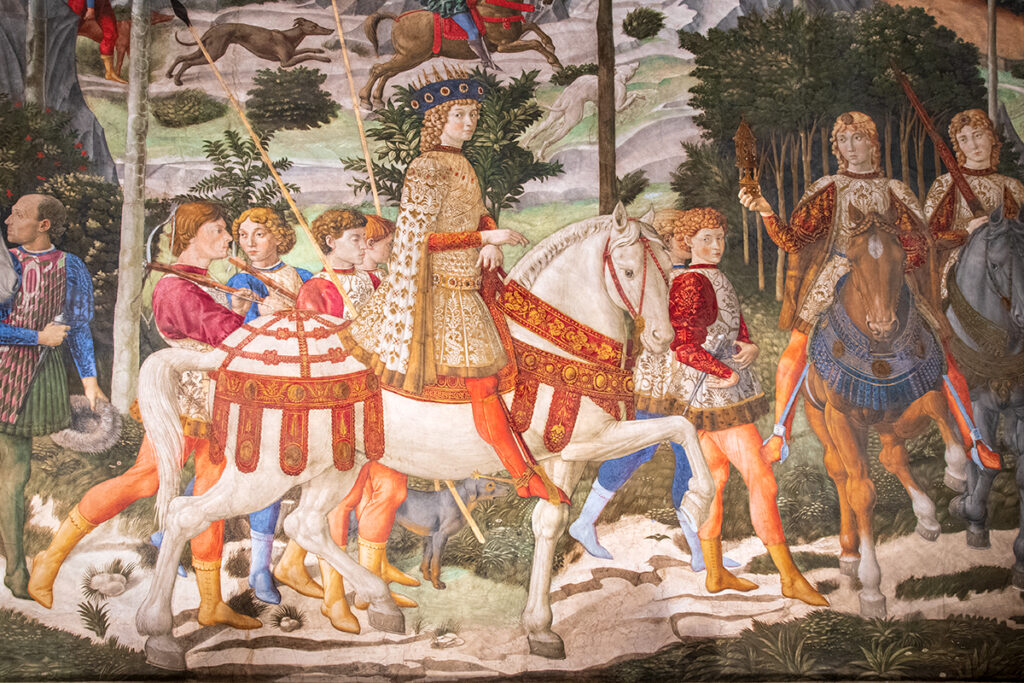
The first of Medici palaces in Florence, Palazzo Medici-Ricardi, was home to the most magnificent of all the Medici – Lorenzo the Magnificent. Under Lorenzo’s patronage, Florence became a centre of artistic innovation and creativity. He supported renowned artists such as Michelangelo, Botticelli, Ghirlandaio and Verrocchio.
While Leonardo wasn’t directly connected to the Medici family, he interacted with and received support from Lorenzo during his time in Florence.
Recognizing Leonardo’s exceptional talent, Lorenzo invited him to join his court as an artist and engineer. Leonardo spent a significant portion of his career in Florence under the patronage of Lorenzo and his family. He worked on various artistic and scientific projects, including painting, sculpture, architecture, and engineering.
It is quite likely that Leonardo visited his patron at Palazzo Medici-Ricardi, which was simply Palazzo Medici at the time.
Piazza San Marco
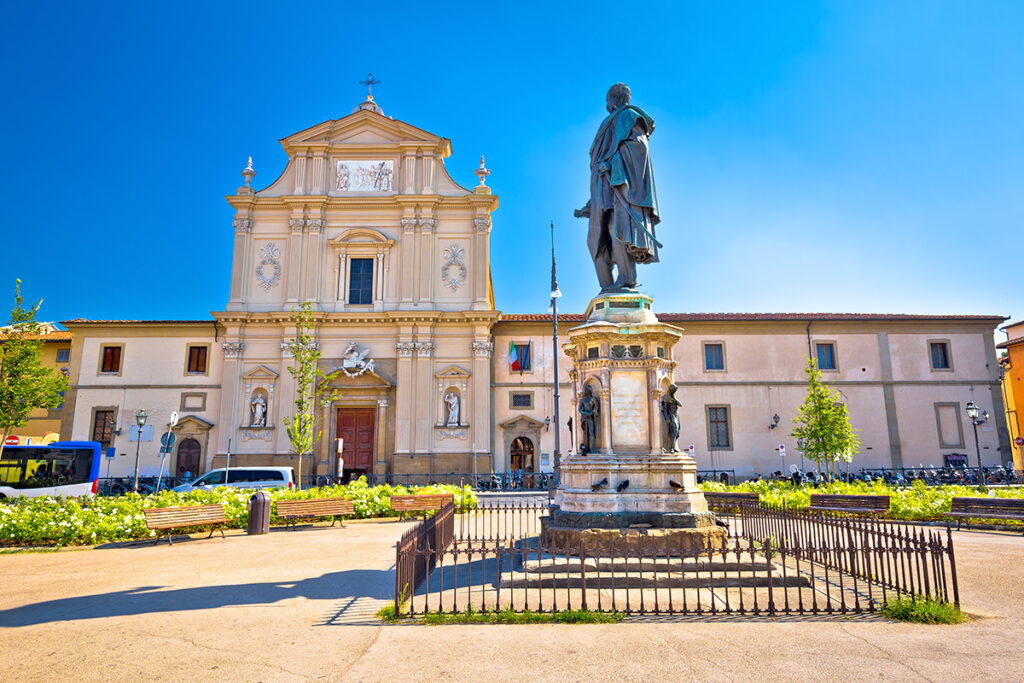
The San Marco square was part of the old Medici Quarter, which also included Palazzo Medici-Ricardi, Basilica di San Lorenzo and San Marco monastery. In Lorenzo Medici’s time, there was a sprawling garden on the square that he allocated to the artists under his patronage.
An anonymous chronicler from the 16th century left a record that Leonardo “stayed, as a young man, with the Magnificent Lorenzo de’ Medici, and giving him provision, he had him work for himself in the garden on the square of San Marco in Florence“.
Duomo
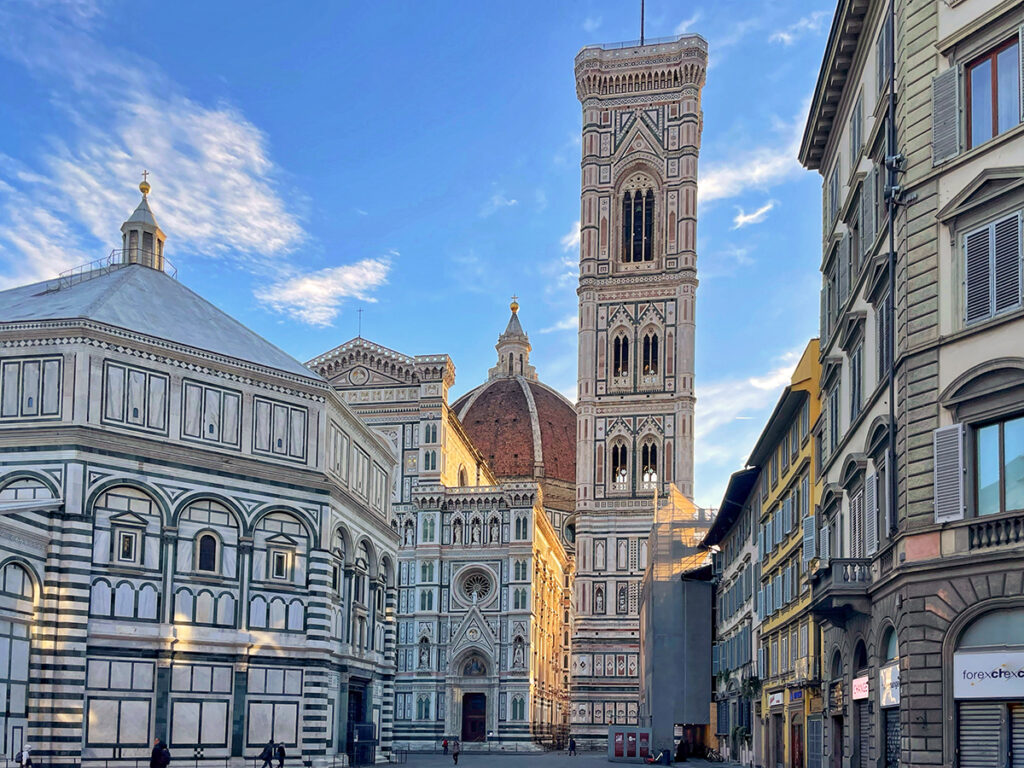
While Leonardo’s name is conspicuously absent from the marble wall at the entrance to the Opera del Duomo museum, which celebrates all the artists who worked on the cathedral complex, there are several connections between Leonardo and the Duomo and the Baptistery.
During Leonardo’s time in Verrocchio’s workshop, he had the opportunity to study the machines invented by Brunelleschi to raise Duomo’s dome to its incredible height. After the dome was completed, Verrocchio was commissioned to create and install a 2-tonn gilded globe on top of the dome, for which he used Brunelleschi’s machines.
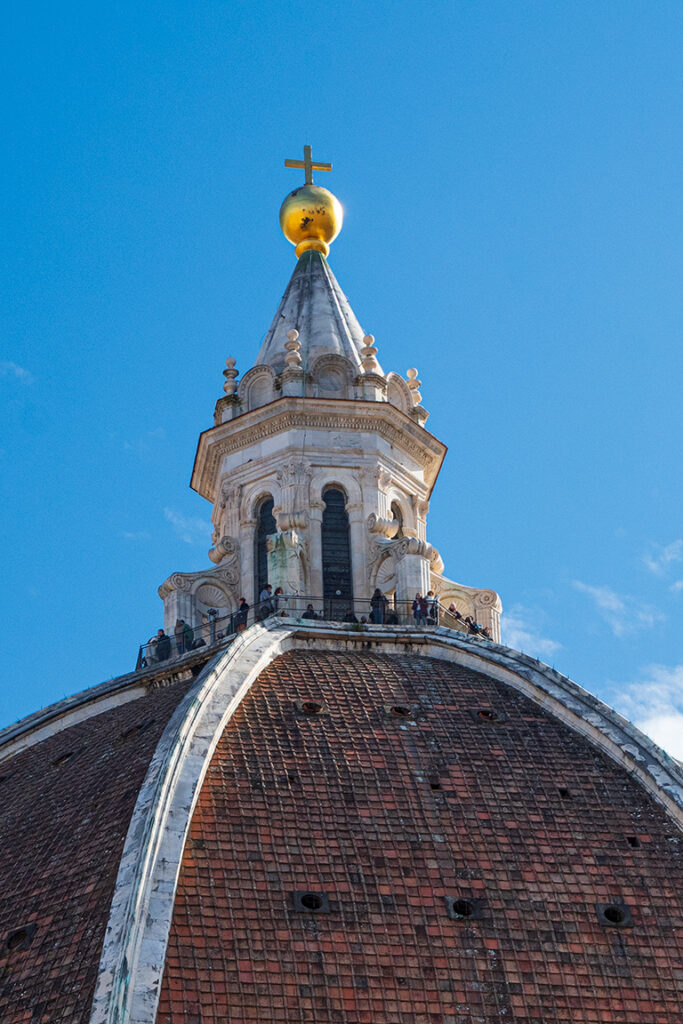
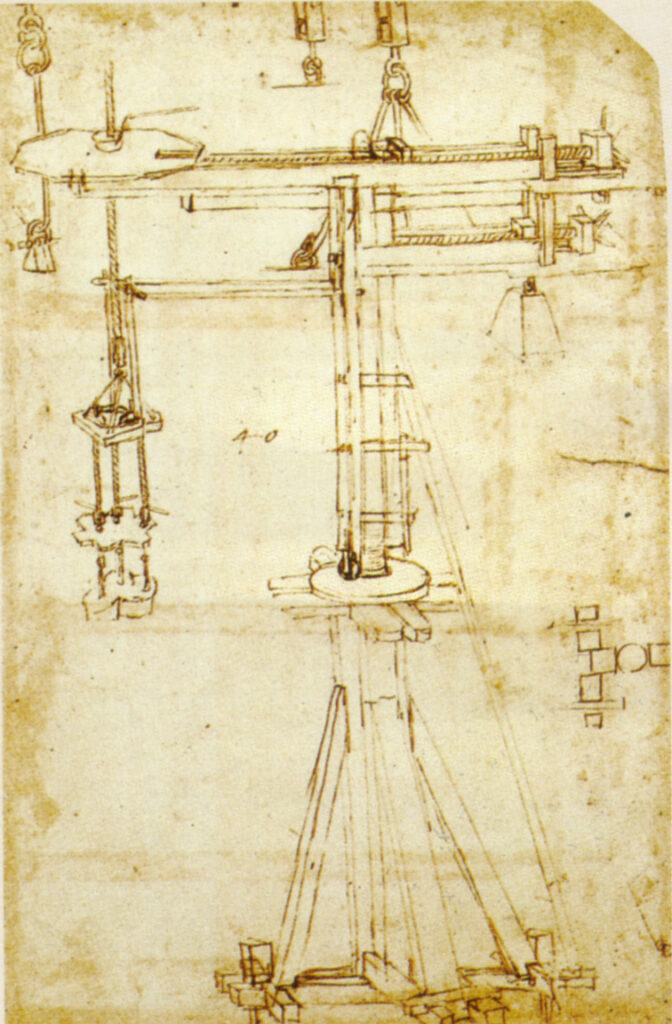
There is little doubt that Leonardo’s curiosity would draw him to such a high-profile artistic project of his master. In fact, Leonardo filled two pages in one of his notebooks, Codex Atlanticus, with the sketches of the crane Verrocchio used to hoist the globe onto the dome.
Baptistery
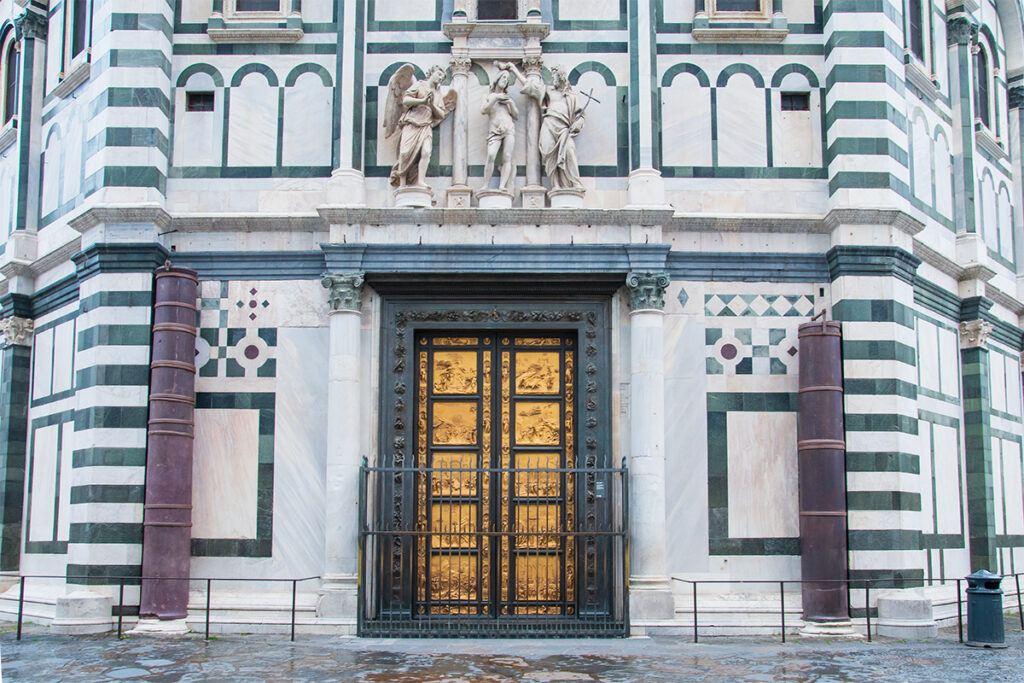
Leonardo’s connection to the Baptistery is even more direct than to Duomo. One of Leonardo’s most ambitious proposals was to raise the Baptistery to its original level. In ancient times, the Baptistery stood on a base with a marble staircase, but over the centuries, the base sunk below the street level.
Leonardo devised a complex plan to raise the building using a series of winches. However, even Leonardo’s genius and charisma were not enough to convince the Florentine government that such an undertaking would be possible.
Years later, Leonardo befriended another of Verrocchio’s pupils, the sculptor Giovan Francesco Rustici. Rustici was commissioned to create bronze statues depicting The Preaching of the Baptist for the Baptistery. The statues were to be placed above one of the Baptistery’s doors.
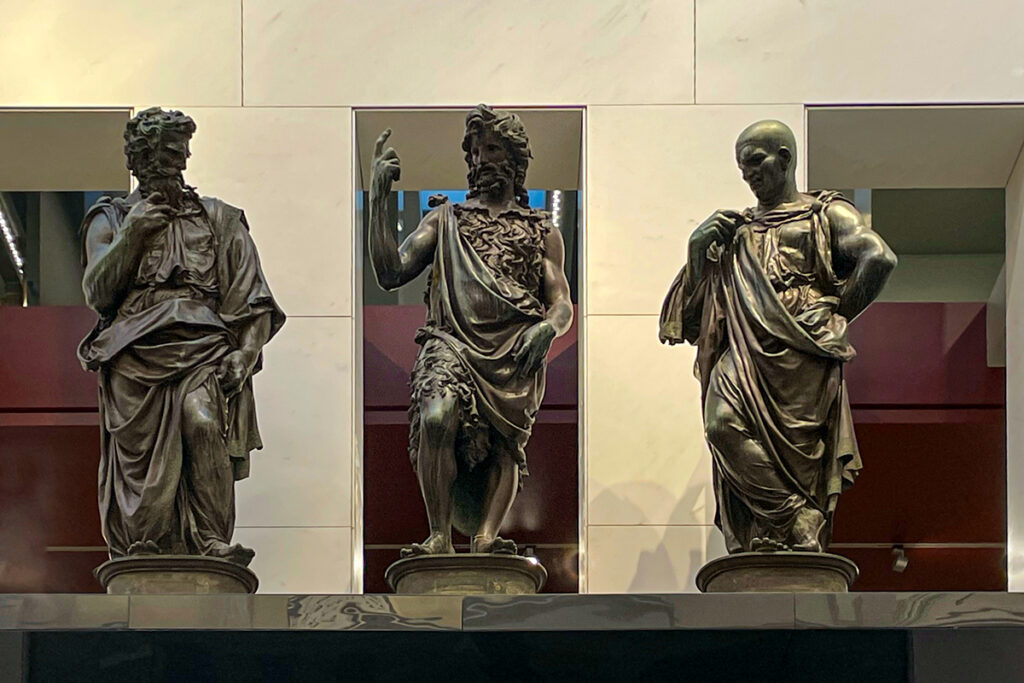
According to Vasari, Leonardo and Rustici lived together at the time at the palace of the Martelli family, and Rustici worked on the statues with Leonardo’s help. It is not known how much Leonardo was involved, but here is what Vasari has to say on the subject:
“Giovan Francesco, while he was fashioning that work in clay, would have no one about him but Leonardo da Vinci, who, during the making of the moulds, the securing them with irons, and, in short until the statues were cast, never left his side; wherefore some believe, but without knowing more than this, that Leonardo worked at them with his own hand, or at least assisted Giovan Francesco with his advice and good judgment”.
Rastici’s statues can be found in the Opera del Duomo museum.
Palazzo Martelli
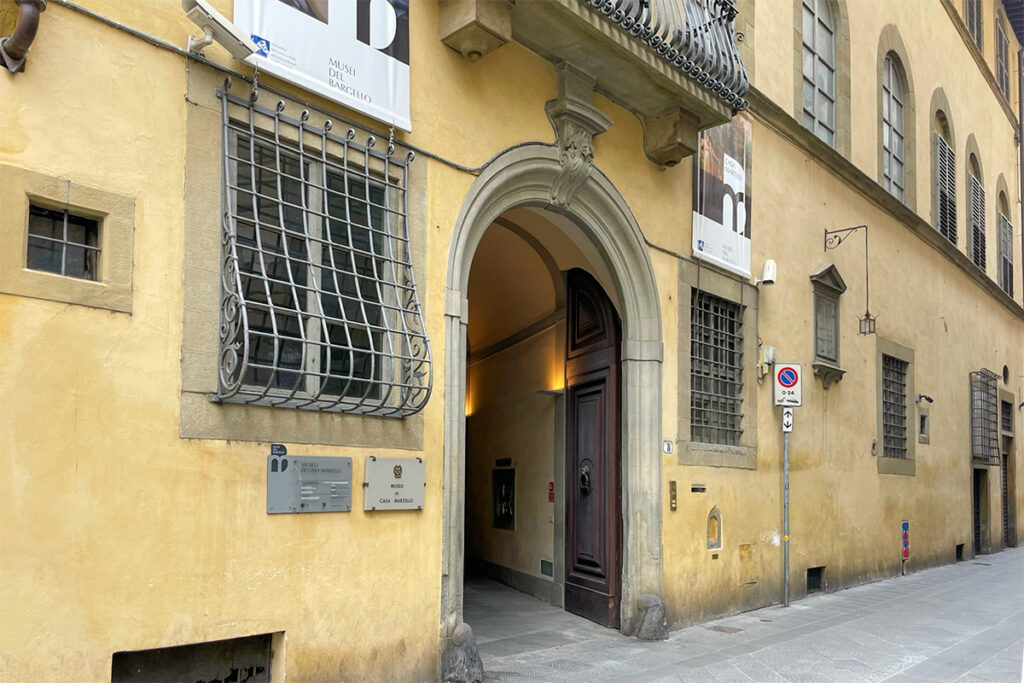
The house of the Martelli family (Casa Martelli), where da Vinci and Rustici stayed while they worked on the sculptures for the Baptistery, is located on Via Ferdinando Zannetti, 8. It is now part of the Bargello Museum, and you can visit it on Tuesdays and Saturdays. It is one of the loveliest hidden gems in Florence, largely overlooked by tourists.
While staying at Martelli’s house, Leonardo began one of his notebooks, known as The Codex of Arundel. His opening entry read:
“Begun in Florence in the Piero di Baccio Martelli house on 22 March 1508. And this will be a collection without order drawn from many papers, which I have copied here, hoping to later put them in order to their places, according to the subjects with which they will treat; and I believe that before I am at the end of this, I will have to repeat the same thing several times”
Santa Maria Novella
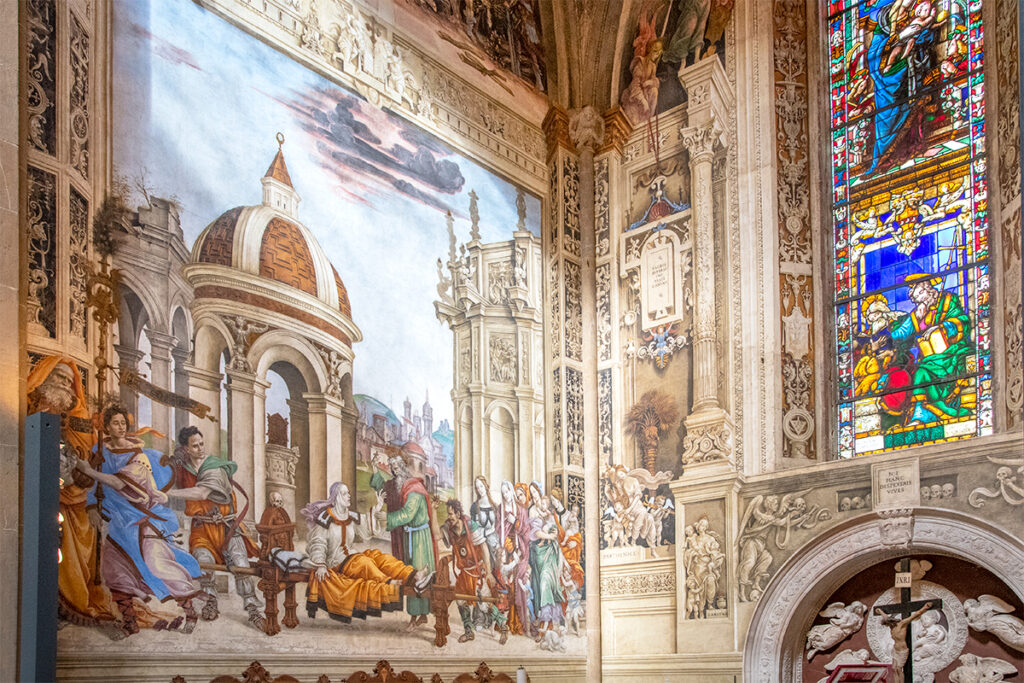
Santa Maria Novella is one of the most beautiful churches in Florence. When Leonardo was commissioned by the Signoria to paint the large mural for Palazzo Vecchio in 1503, he stayed with the Dominican monks at Santa Maria Novella and worked in the church to draw the full-scale cartoon for his Battle of Alighieri.
As with all his artistic pursuits, Leonardo spent a long time working on the drawing, and he drew inspiration from the works of Brunelleschi, Ghirlandaio, and Giotto that surrounded him in the church.
Verrocchio Workshop – Bottega del Verrochhio
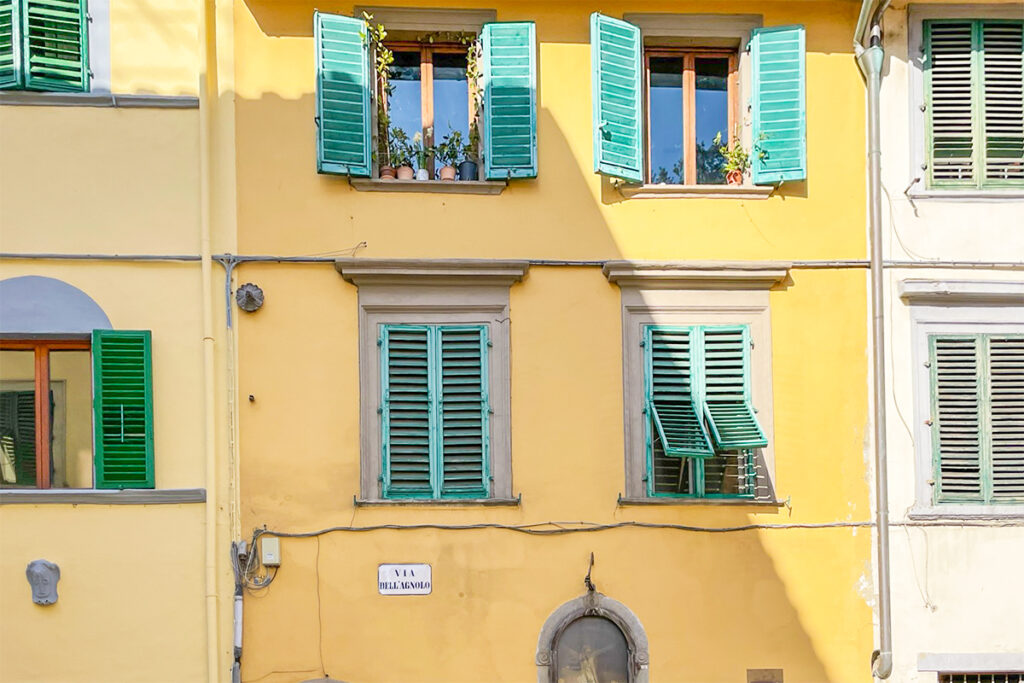
Verrocchio’s workshop is, of course, long gone. But since the address of the building where the workshop was located is known, you can go for a walk along the exact street that Leonardo would’ve walked daily during his apprenticeship.
Verrocchio family owned a house at the cross of via dell’Agnolo with “Via Pentolini sive Malborghetto” (now via de’ Macci). Don’t expect to see much on that street corner today. But you can enjoy walking in Leonardo’s footsteps here.
Bargello Museum
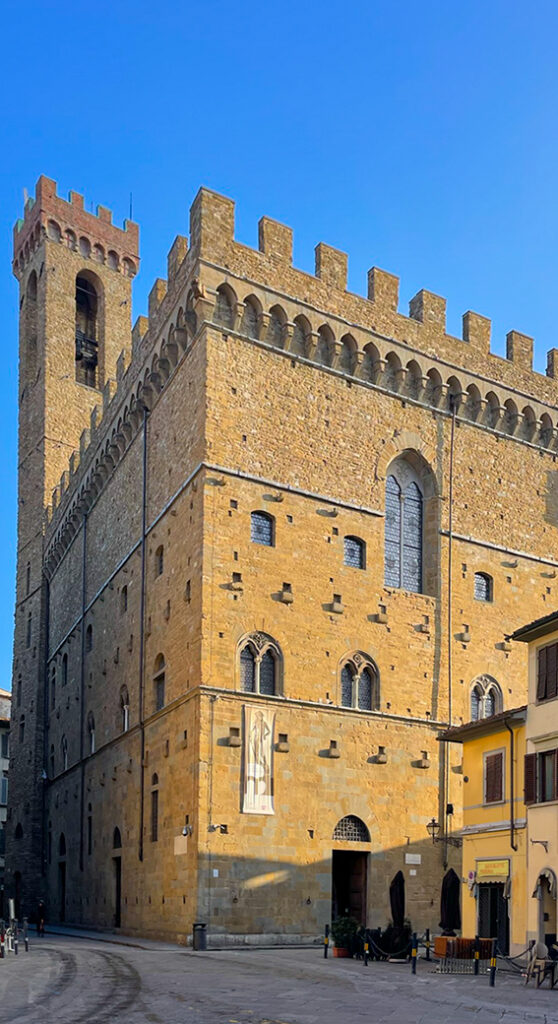
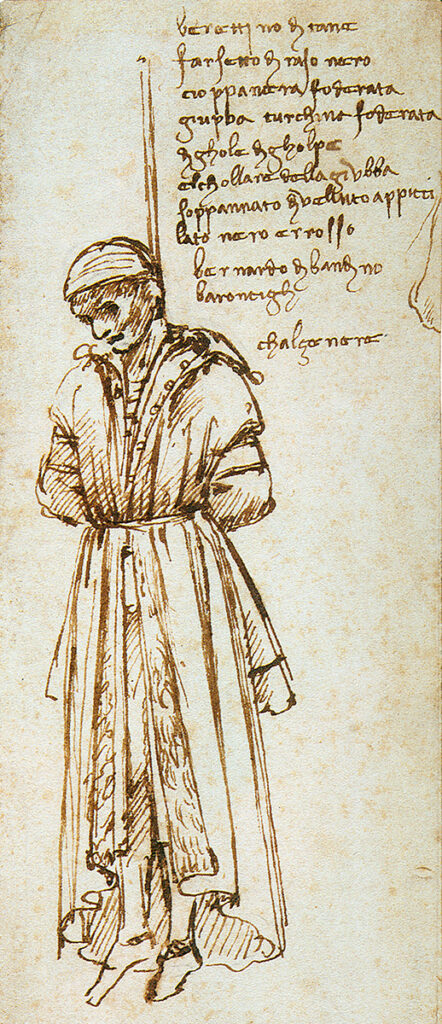
In Leonardo’s time, the building we know as the Bargello Museum was called Palazzo del Podesta, and it was the largest civic building in Florence. When Leonardo and his far Ser Piero moved to Florence in 1469, Ser Piero worked as a notary at the Palazzo del Podesta.
Ten years later, members of the Pazzi family plotted to overthrow the Medici family by killing Lorenzo and Giuliano Medici. The conspirators succeeded in killing Giuliano but only wounded Lorenzo, who exacted swift revenge on the members of the Pazzi conspiracy.
One of the conspirators, Bernardo di Bandidi Baroncelli, fled to Constantinople, but the Turks captured him and handed him over to Lorenzo. On December 29, 1479, Baroncelli was hanged in the Palazzo del Podesta and afterwards ‘exhibited’ in Piazza della Signoria.
Leonardo sketched a drawing of the Hanged Man, dispassionately noting his clothes: tulle cap, black satin doublet…
Inside the Bargello Museum, you can find Rustici’s small terracotta composition of da Vinci’s Battle of Anghiari. Since Rustici and Leonardo were quite close, sharing lodgings at Palazzo Martelli and potentially working together on the statues for the Baptistery, it is not surprising that the younger sculptor was inspired by Leonardo’s work and replicated it in his own art.
Verrocchio’s David
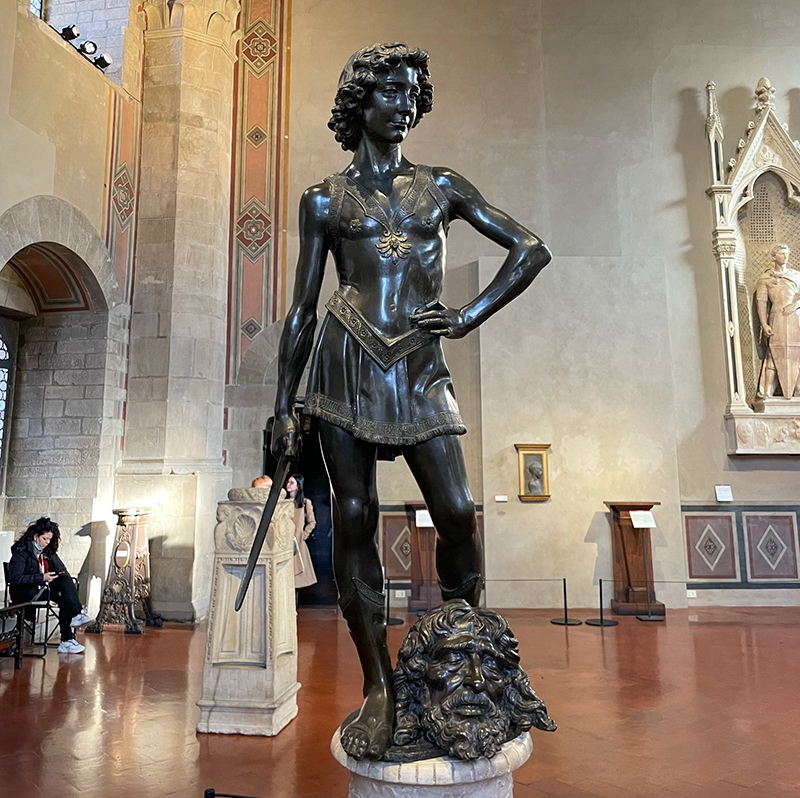
Another throwback to Leonardo at the Bargello museum is Verrocchio’s sculpture of “David and Goliath”, created on commission by Piero de Medici, Cosimo the Elder’s son. According to a popular legend, the model for the statue was Leonardo da Vinci, a young apprentice in Verrocchio’s studio at the time.
Basilica della Santissima Annunziata
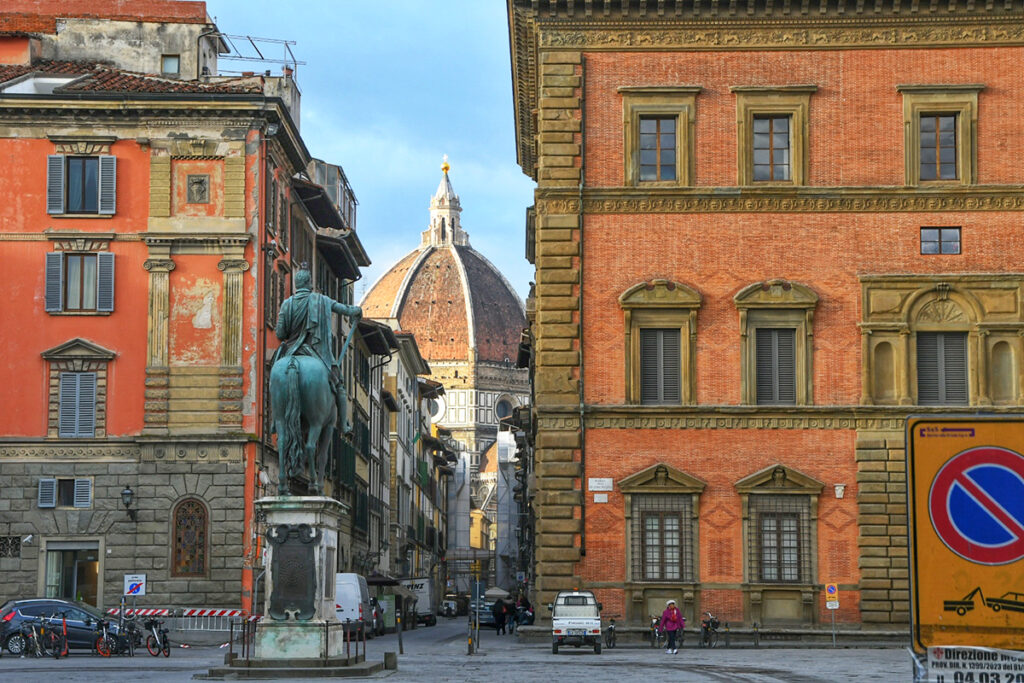
On his return to Florence in 1500, Leonardo accepted the commission for the altarpiece for the high altar of the Santissima Annunziata. Originally, the friars commissioned Filippino Lippi for the job, but when Lippi heard that the great master da Vinci was interested in the commission, he graciously walked away.
The friars provided Leonardo with lodgings at the convent for the duration of his work. And while Leonardo spent a long time staying with the monks, he never started the commission. Instead, he is believed to have painted his famous The Virgin and Child with Saint Anne, which may have been commissioned by the King of France and is currently housed in the Louvre.
The rooms where Leonardo and his apprentices may have stayed have been discovered next door at the headquarters of the Military Geographical Institute. During the renovations in 2005, when workers demolished a wall, they came across a secret stairwell and several small rooms, now believed to be Leonardo’s lodgings.
Santa Maria Nuova Hospital
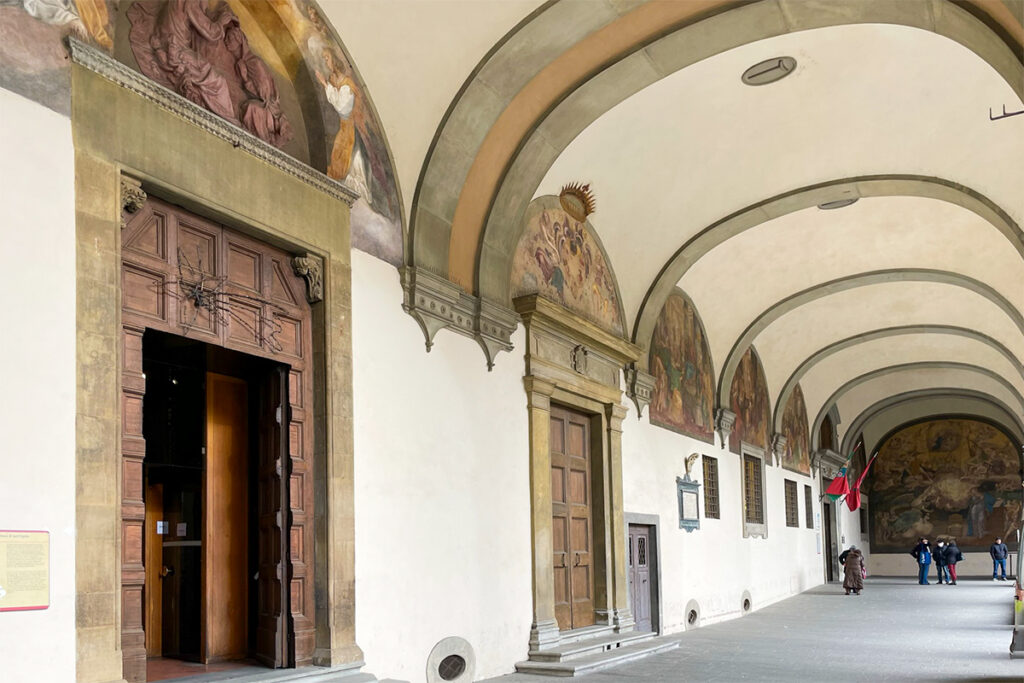
Santa Maria Nuova Hospital is the oldest hospital still active in Florence. It is also the place where Leonardo performed his anatomical studies. As if being the world’s most talented artist and inventor way ahead of his time, Leonardo also made great advances in the field of anatomy. In fact, he was the first to describe a condition we know as arteriosclerosis.
Ironically, the reason we know about this is that Leonardo was accused of secretly stealing corpses from the hospital morgue to use them as anatomical models for his drawings. In response to the accusations, Leonardo wrote in a letter (currently at the Royal Library of Windsor):
“And this old man, a few hours before his death, told me he had gone one hundred years and that he did not feel any weakness in his person other than weakness. And so, sitting on a bed in the hospital of Santa Maria Nova in Florence, without any other movement or sign of any accident, he passed from this life. And I made an examination of it to see the cause of such a sweet death: which I found failing due to lack of blood and artery, which feeds the core and the other lower limbs, which I found many arid, exhausted and dry.
This anatomy I described very diligently and with great ease, being deprived of fat and humour, which greatly impedes the knowledge of the parts. The other anatomy was of a two-year-old child, in which I found everything contrary to that of the old man.”
Leonardo da Vinci Museum
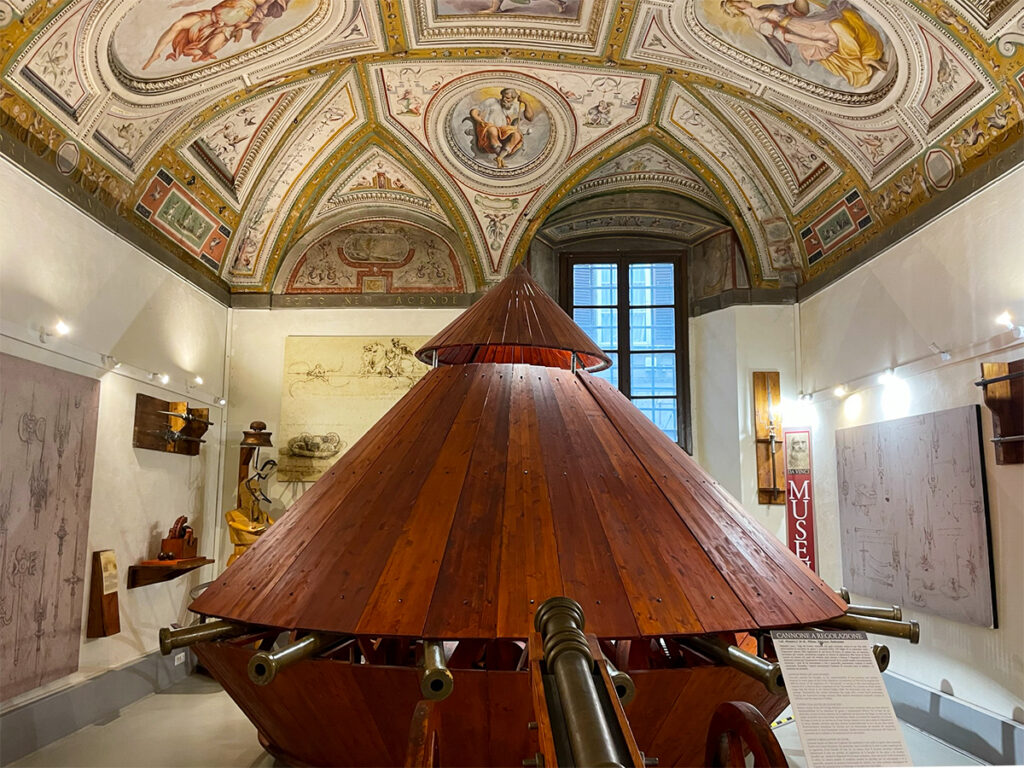
While known mostly as an artist, the creator of the world’s most famous portrait, the Mona Lisa, Leonardo considered himself more of an inventor than an artist. He designed countless machines and mechanisms, including a prototype helicopter, a tank, a scuba diving device and various gadgets for flying machines, to name a few.
Most of these inventions were so far ahead of their time that there were no practical means to build them. Centuries would pass before Leonardo’s inventions were transformed into physical artifacts. There are several museums in Italy that exhibit models assembled from Leonardo’s drawings, and one of them is in Florence.
Leonardo da Vinci Interactive Museum, near the Duomo, is a fascinating world that offers a glimpse into the mind of a genius. The models of dozens of machines are displayed across several rooms, and many are interactive, so you can get a sense of how they work.
Palazzo Feroni-Ferragamo
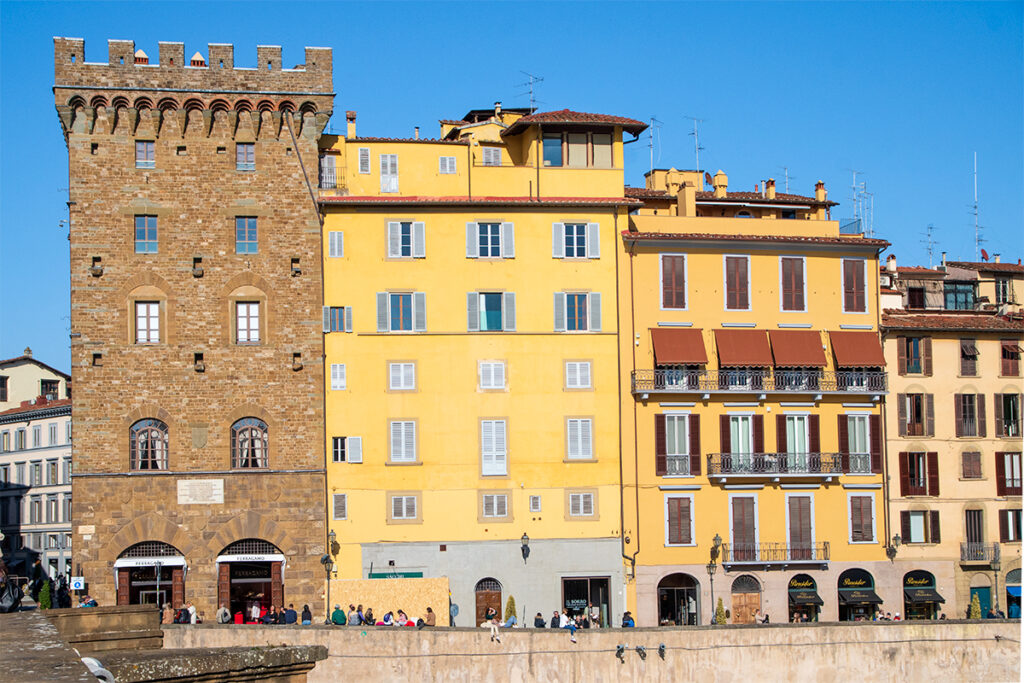
As you cross the Arno River over the Santa Trinita bridge, you’ll come across Palazzo Feroni-Ferragamo (Feroni-Ferragamo Palace) – in front of which Leonardo had a public quarrel with his rival Michelangelo.
As the story goes, a group of intellectuals were gathered on the public benches at the Palazzo Feroni, discussing a passage from Dante when Leonardo walked by with his friend Giovanni di Gavina. The men called out to Leonardo, asking him to explain the meaning of the passage. At the same moment, Michelangelo walked by, and Leonardo gestured towards him, announcing that “Michelangelo will explain it to you.”
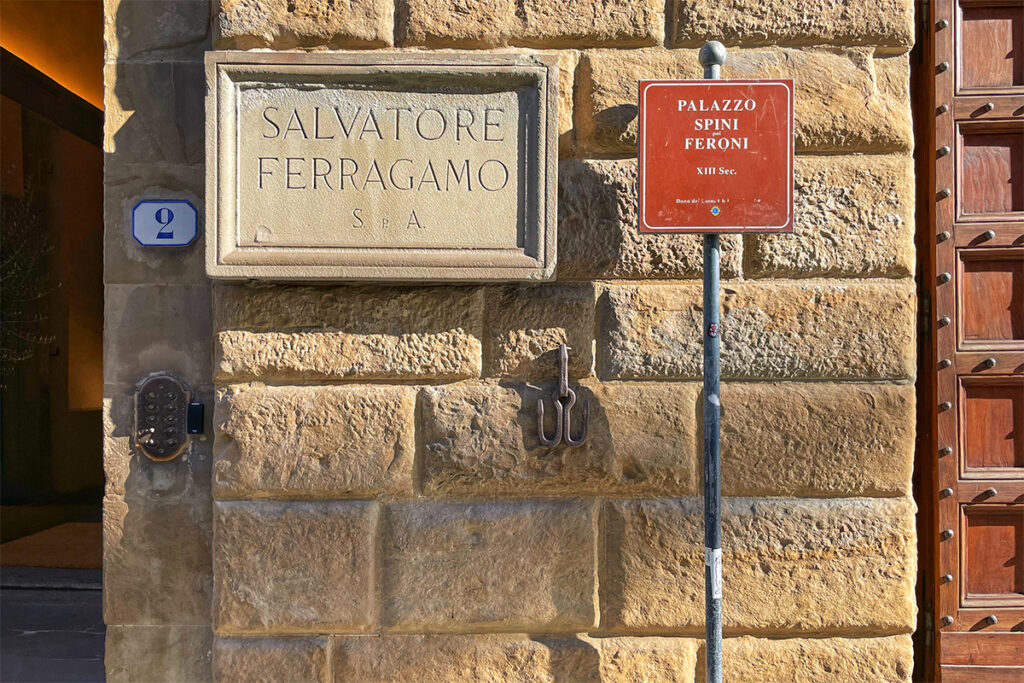
Given the rivalry between the artists, Michelangelo took Leonardo’s remark as a sign of mockery and retorted: “No, you explain – you who have undertaken the design of a horse to be cast in bronze but were unable to cast it and were forced to give up in shame”, referring to Leonardo’s ambitious project for the Duke of Milan that was never finished, like many Leonardo’s undertakings.
Walking away, Michelangelo added, “And to think you were believed by those castrated Milanese roosters!” Leonardo was left blushing and humiliated.
The Frame Hotel
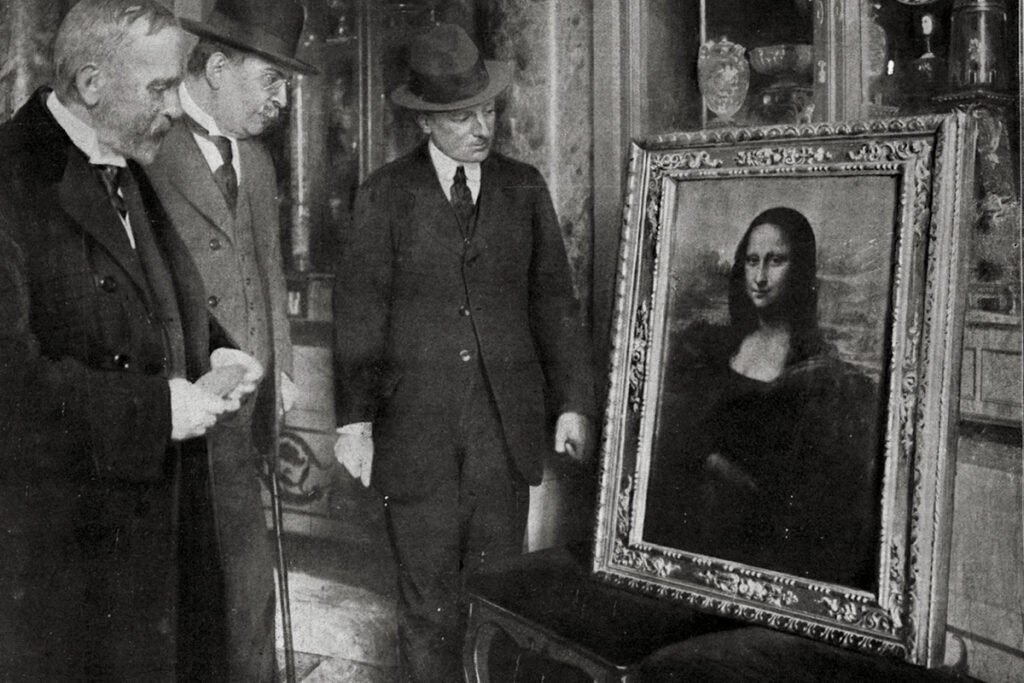
Leonardo’s most famous painting, the Mona Lisa, the portrait of Lisa del Giocondo, while painted in Florence, spent most of its 500 years in France, purchased by King Francis I of France shortly after Leonardo’s death in 1519 in France.
The little-known fact about the Mona Lisa is that the painting returned to Italy for a brief visit when, in 1911, it was stolen from the Louvre by an Italian museum worker, artist and thief – Vincenzo Peruggia.
Peruggia was finally arrested in Florence in Hotel Tripoli, where the police also found the Mona Lisa under a bed in room 20. Today, the hotel goes under the name of The Frame Hotel, and you can find it (or stay there!) at No. 2 Via Panzani.
For a short period after the robbery, the Mona Lisa was exhibited in the Uffizi Gallery before it was returned to France.
Did you know: Whether this painting is the Mona Lisa Leonardo painted in 1503-1506 remains a mystery. Around the same time as Peruggia’s theft, another painting surfaced in England that appears to be the portrait of Lisa del Giacondo but at a much younger age. Known as Isleworth Mona Lisa, this painting could be the ‘original’ Mona Lisa. The woman in the painting is not only younger but much more beautiful than in the Louvre version. The Isleworth Mona Lisa fits Vasari’s description of Leonardo’s painting much better.
Judge for yourself. Here is how Vasari described the Mona Lisa in his famous Lives of the Most Excellent Painters, Sculptors, and Architects published in 1550.
….the eyes had that lustre and moistness which are always seen in the living creature, and around them were the lashes and all those rosy and pearly tints that demand the greatest delicacy of execution. The eyebrows, through his having shown the manner in which the hairs spring from the flesh, here more close and here more scanty, and curve according to the pores of the flesh, could not be more natural. The nose, with its beautiful nostrils, rosy and tender, appeared to be alive. The mouth with its opening, and with its ends united by the red of the lips to the flesh-tints of the face, seemed, in truth, to be not colours but flesh. In the pit of the throat, if one gazed upon it intently, could be seen the beating of the pulse: and indeed it may be said that it was painted in such a manner as to make every brave artificer, be he who he may, tremble and lose courage.
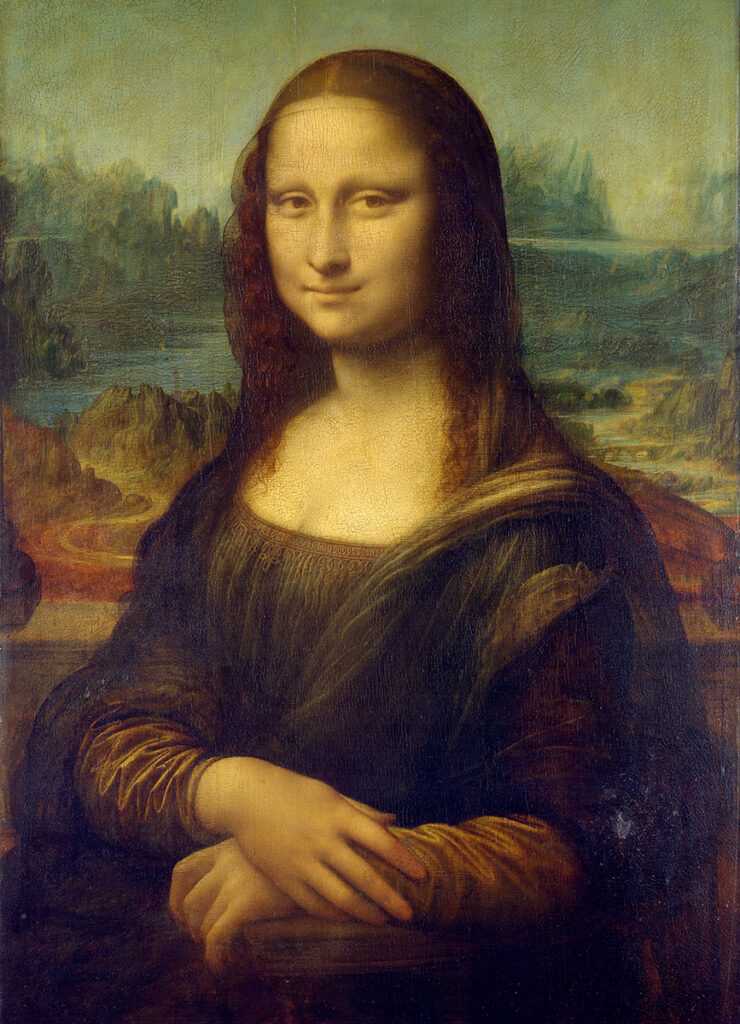
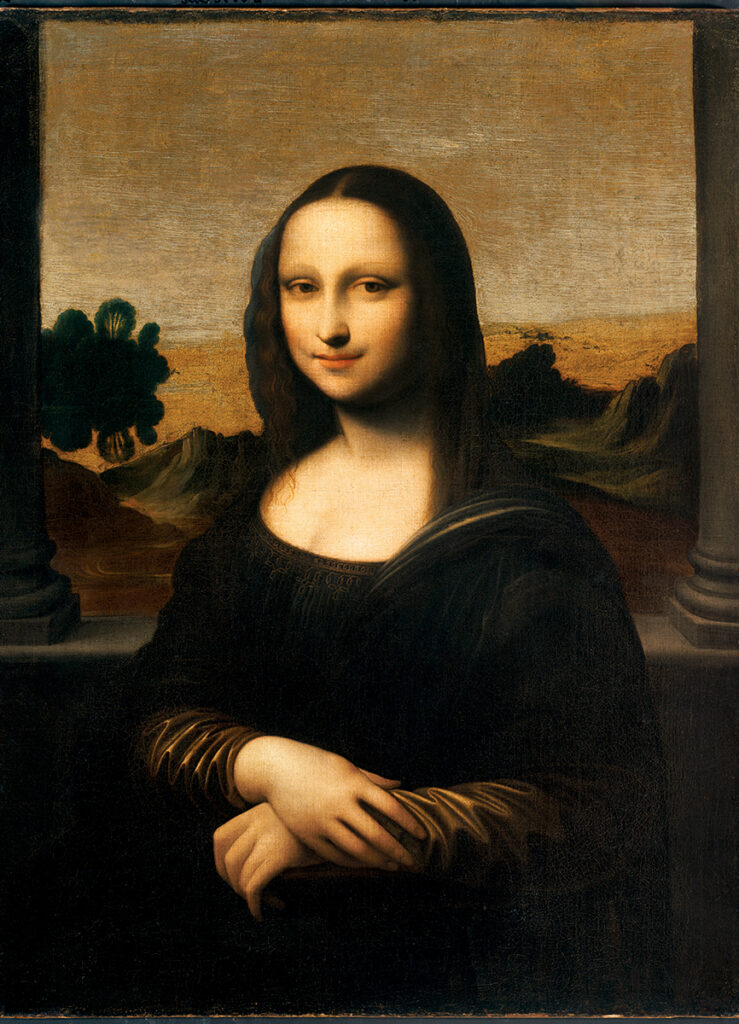
He employed also this device: Mona Lisa being very beautiful, while he was painting her portrait, he retained those who played or sang, and continually jested, who would make her to remain merry, in order to take away that melancholy which painters are often wont to give to their portraits. And in this work of Leonardo there was a smile so pleasing, that it was a thing more divine than human to behold, and it was held to be something marvelous, in that it was not other than alive.”
Brancacci Chapel
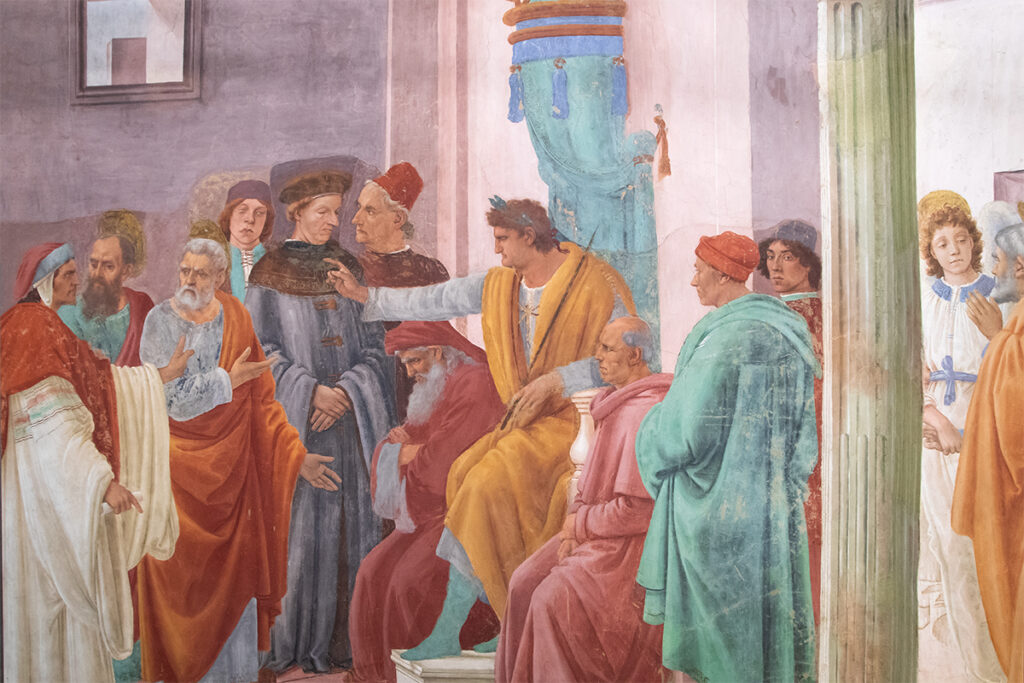
To get a sense of the artistic landscape that Leonardo found in Florence, visit the nearby Brancacci chapel in the Church of Santa Maria del Carmine. It is one of Italy’s most beautiful chapels, and the stunning frescoes by Masaccio and Masolino in the Brancacci Chapel are considered some of the greatest masterpieces of Renaissance art.
According to Giorgio Vasari, the Florentine artist and art historian, all the most celebrated painters and sculptors in Florence, including Leonardo da Vinci, came to study Masaccio’s monumental life-like figures and his use of light and shadow to create a 3-dimensional effect.
Basilica di Santo Spirito
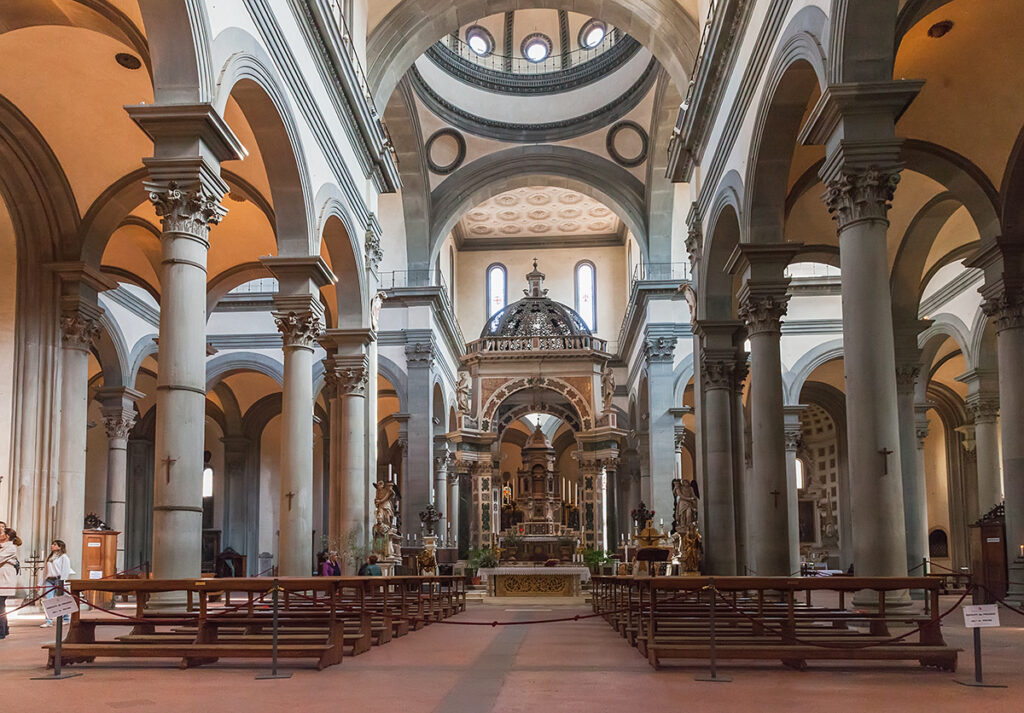
Just a couple of blocks away, there is Brunileschi’s last masterpiece – Basilica di Santo Spirito. The church facade is so simple you could walk right past it. But the interior of the basilica is a masterpiece of artistic geometric symmetry. Leonardo mentioned Basilica di Danto Spirito in one of his notebooks, Codex Atlanticus, around 1505.
Porta Romana
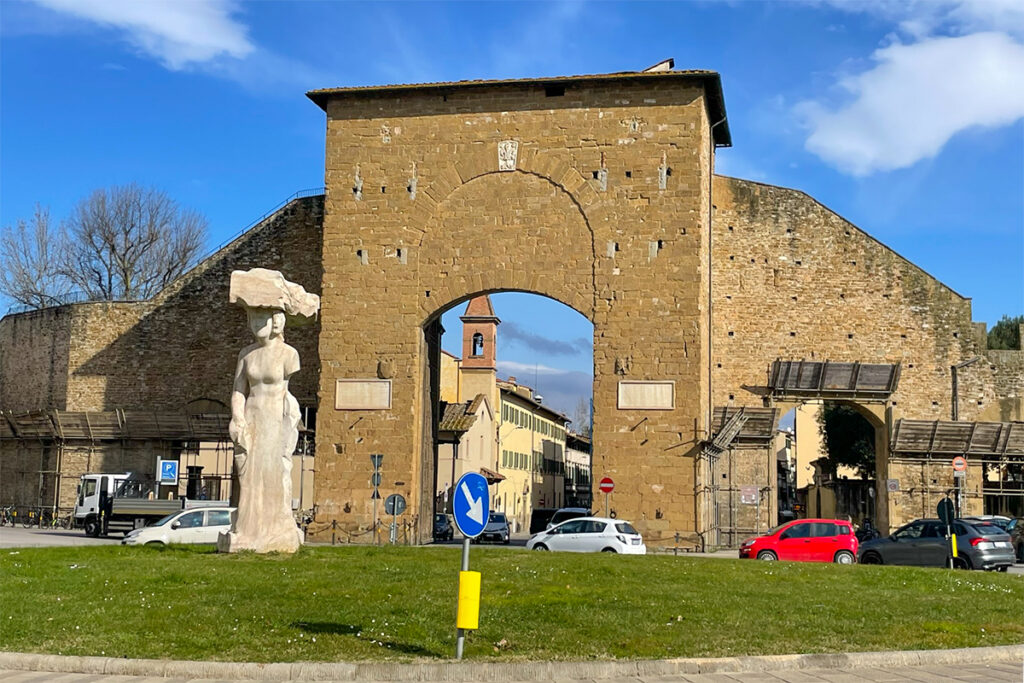
End your Leonardo da Vinci Florence walk on the south bank of the Arno River and enter the city through one of its ancient gates – Porta Romana. In Leonardo’s time, Florence was encircled by a city wall punctuated by ten massive gates, many of which still stand.
Not much is left of the Florentine city wall, but if you are keen to see medieval city walls in Tuscany, consider a day trip from Florence to Lucca. Da Vinci designed Lucca’s walls and you can still see them today.
In 1515, Leonardo traced the schematic and idealized plan of Florence, including the representation of the city walls and the gates.
Porta Romana is also featured in Dan Brown’s Inferno – Robert Langdon and Siena Brooks entered Florence through this ancient gate.
And this is where our journey of discovering the traces of Leonardo da Vinci in Florence comes to an end. You could walk this itinerary in a day or pick a few places to add to your Florence explorations.
How to Get to Florence
The most convenient way of getting to Florence is by high-speed train. Driving & parking in Florence can be a chaotic nightmare, and the high-speed trains are faster and more relaxing than flying. Direct trains from Roma Termini depart every 30 minutes, taking just over 1.5 hours.
The easiest way to book train tickets in Italy is via the Omio app. You can show your electronic tickets to the conductor in the app – no need to print anything. And you’ll have all your train tickets in the same place regardless of what train network you travel with.
Where to Stay in Florence
I spent almost two weeks in Florence staying at Locanda Orchidea and I could recommend this charming B&B highly enough. Located in a 13th-century historical palace, Torre di Donati, that may have belonged to Dante’s family, Locanda Orchidea is full of character.
And conveniently located a 5-minute stroll to Piazza del Duomo, a 10-min stroll to Piazza della Signoria, and a 10 min stroll to the street where Verrocchio’s workshop used to be. You could say it is the heart of Leonardo’s Florence.
More on Exploring Italy
- Renaissance Cats in Florence – A Feline Lovers Guide to Florentine Renaissance Art
- 3 Days in Florence – Exploring the Cradle of the Renaissance
- 2 Days in Florence: Detailed and Flexible Itinerary & Tips
- 1 Day in Florence Itinerary – the Best of the Italian Renaissance
- Things to Do in Florence in Winter and Why Visit in Winter
- Leonardo da Vinci in Florence: In the Footsteps of the Renaissance Master
- Guide to Visiting Palazzo Vecchio: Must-see Art and Hidden Gems
- Medici Florence – a Self-Guided Walk in the Cradle of the Renaissance
- 18 Weekend Breaks in Italy: Top Destinations to Visit and Things to Do
- Quo Vadis – Assisi B&B Where Comfort Meets Medieval Charm

